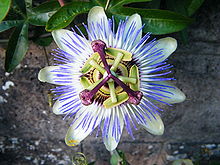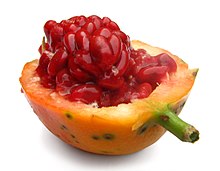Passiflora caerulea
| Passiflora caerulea | |
|---|---|

| |
| Passiflora caerulea in flower | |

| |
| Passiflora caerulea fruit cut and opened | |
| Scientific classification | |
| Kingdom: | |
| (unranked): | |
| (unranked): | |
| (unranked): | |
| Order: | |
| Family: | |
| Genus: | |
| Species: | P. caerulea
|
| Binomial name | |
| Passiflora caerulea | |
Passiflora caerulea, the blue passionflower,[1] bluecrown passionflower[2] or common passion flower, is a species of flowering plant native to South America (Argentina, Chile, Paraguay, Uruguay and Brazil). It is a vigorous, deciduous or semi-evergreen tendril vine growing to 10 m (33 ft) or more, with palmate leaves and fragrant, blue-white flowers with a prominent fringe of coronal filaments in bands of blue, white, and brown. The ovoid orange fruit, growing to 6 cm (2 in), is edible but bland.[3]
Names
This popular and showy plant has attracted a number of common names. In Paraguay it is widely known as mburucuyá in Guaraní. Other names include blue crown, flower of five wounds, southern beauty, wild apricot, Jesus flower. The specific epithet caerulea means "blue" and refers to the blue coronal filaments.[4] In Japan, it's called 時計草 ( Clock plant ) due to having 12 petals, a central stamens and stigmas resembling a timepieces's winding mechanism, and curly green tendrils resembling wound springs.
Description

Passiflora caerulea is a woody vine capable of growing to 15–20 m high where supporting trees are available. The leaves are alternate, palmately five-lobed like a spread hand (sometimes three or seven lobes), 10–18 cm long and wide. The base of each leaf has a flagellate-twining tendril 5–10 cm long, which twines around supporting vegetation to hold the plant up.
The flower is complex, about 10 cm in diameter, with the five sepals and petals similar in appearance, whitish in colour, surmounted by a corona of blue or violet filaments, then five greenish-yellow stamens and three purple stigmas. The fruit is an oval orange-yellow berry 6 cm long by 4 cm in diameter, containing numerous seeds; it is eaten, and the seeds spread by mammals and birds. It is edible to humans, but bland in flavour. In tropical climates, it will flower all year round.
Cultivation
Passiflora caerulea is widely cultivated as a wall-climber or as groundcover. In milder temperate areas it can be grown outside, and can become invasive, the twining shoots constantly appearing unless eradicated. It has gained the Royal Horticultural Society's Award of Garden Merit.[5]
Cultivars

A number of cultivars have been produced from the species:-
- 'Chinensis' (corona filaments paler blue)
- 'Constance Elliott' was raised by Kucombe and Prince in Exeter, Great Britain. It has pure white, fragrant flowers; not as free-flowering as many other clones.
- 'Grandiflora' (flowers to 20 cm in diameter)
- 'Hartwiesiana' (flowers white)
- 'Regnellii' (very long corona filaments)
The species has been used in numerous hybrids.
Other uses
Though the fruit is edible, it is rather insipid when eaten raw. It can substitute for blackberries. A tea can be made of the flower which is said to alleviate stress and anxiety. However, tetraphyllin B and epi-tetraphyllin B, cyanogenic glycosides (which liberate hydrogen cyanide when activated by enzymes), have been found in the leaves. It is possible to boil away most of the cyanide.[6]
In culture
The flower of the passion fruit is the national flower of Paraguay. The intricate structure of the flower has generated Christian symbolism, each part representing a different part of the Passion of Christ. See Passiflora "Etymology and names" section for more information about the symbolism.
Gallery
-
fruit
-
A closeup a blue passionflower
-
The flower of P. caerulea
-
Constance Elliot a white flower form
References
- ^ "BSBI List 2007". Botanical Society of Britain and Ireland. Archived from the original (xls) on 2015-02-25. Retrieved 2014-10-17.
- ^ NRCS. "Passiflora caerulea". PLANTS Database. United States Department of Agriculture (USDA). Retrieved 31 January 2016.
- ^ RHS A-Z encyclopedia of garden plants. United Kingdom: Dorling Kindersley. 2008. p. 1136. ISBN 1405332964.
- ^ Harrison, Lorraine (2012). RHS Latin for gardeners. United Kingdom: Mitchell Beazley. p. 224. ISBN 9781845337315.
- ^ "RHS Plant Selector - Passiflora caerulea". Retrieved 25 May 2013.
- ^ DS Seiglera, KC Spencera, WS Statlerb, EE Connb, JE Dunnb, 'Tetraphyllin B and epitetraphyillin B sulphates: Novel cyanogenic glucosides from Passiflora caerulea and P. alato-caerulea', Phytochemistry, 21/9 (1982), 2277-2285.




